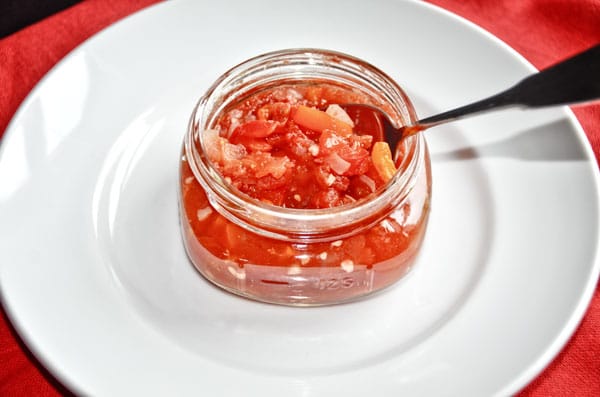Say adiós to summer with delicious salsa


Article and photo by Lisa Crockett
It’s harvest time, and after a trip to the farmers market, my kitchen is a veritable vegetable wonderland. Zucchini and eggplant are sliced and roasted, corn is slapped on the grill and given a slather of butter and a sprinkle of salt. Carrots and cucumbers just get sliced and devoured. Delicious and so good for me that I sometimes eat to excess. My favorite, by far, are the gorgeous tomatoes, fat and juicy and with a flavor that evokes warm days, cool evenings, and all the things I love about the season. I generally eat them so fast that they’re consumed long before there is any question about them going bad. This year, though, I was gifted a large quantity of tomatoes … so many that even I (and my family) couldn’t consume them before they turned; eating them all would have been a round-the-clock effort.
And so, staring at the bumper crop lining my kitchen counters, I began to contemplate what I might do with them. Usually when I have an excess of produce, I freeze whatever I can’t use right away, but tomatoes aren’t a good candidate for the freezer. Freezing, like refrigeration, isn’t a good match for a tomato’s delicate and tender texture.
I suppose I could have given the tomatoes away, but I must confess to feeling a bit selfish. These tomatoes were amazing, and I kind of wanted to keep them for myself. And so, given the extreme circumstances I found myself in, I decided to pull out my canning equipment.
Canning isn’t for the faint of heart. It’s precise, it’s time consuming, and it’s invariably hot in the kitchen when you do it. And after all that, there’s no guarantee it will actually work – I’ve had a few batches of produce that just didn’t come out as planned, despite my best efforts. Canning is hard work, so adding the element of chance to the proposition doesn’t generally fill me with desire to run to the kitchen. Still, those tomatoes were too good to let go to waste, so I overcame my childhood memories of helping my mom can while she stood, sweating, over the stove, and got down to business.
Canning also carries some risk – food safety is a real concern for home canning, so it’s best to always use a tested recipe with a seal of approval from some group or company that knows what it is that makes food safe (recipe acidity levels are important, so using a recommended recipe ensures you don’t have to guess about what levels are safe). Water bath canning, the method I used for the salsa I’ve shared here, is generally pretty simple, but I never use a recipe that isn’t “vetted” for safety. Water bath canning is appropriate for pickles, fruit, and tomatoes (canning vegetables requires the use of a pressure canner; for more information on canning, visit page 30.)
I perused the website for the Colorado State University Extension (extension.colostate.edu/) and found the recipe I’ve shared here. It’s a laborious and time-consuming process – peeling the tomatoes, draining them, chopping them, chopping all the other ingredients, cooking them, sterilizing the jars and lids, and finally giving the finished product a “bath” in boiling water takes a good, long while. After hours in the kitchen, as I stared at the mountain of dirty dishes waiting to be washed, I ran my wrist across my forehead and wondered if I had made a terrible mistake. I set my jars on a clean towel to cool and decided to open one jar to test my handy work. I put a spoonful in my mouth, and suddenly the dishes, the heat and the annoyance all seemed worth it. The tomatoes and peppers (nearly all very mild peppers in my case; I used just three jalapeños for heat) were full of flavor. They filled my mouth with a taste that can only be described as “summery.” And with the jars safely stowed in my pantry, I’ll be able to enjoy that flavor all year long.
Chili Salsa
This recipe was taken from the website of the Colorado State University Extension; for more information visit extension.colostate.edu. If you do not wish to can your salsa, simply follow instructions below for cooking, pour into glass or plastic containers and store in the fridge.
12 cups peeled, cored, chopped tomatoes (choose a meaty variety or squeeze out extra juice)
6 cups seeded, chopped chili peppers*
1 1/2 cups finely chopped onions
1/4 cup finely chopped garlic
1 cup vinegar
1 tablespoon salt
1/2 teaspoon pepper
*Use mixture of hot and mild peppers to suit taste.
Yield: Makes 6 to 8 pints
Combine ingredients in large saucepan. Heat to a boil and simmer 10 minutes. Ladle hot into clean pint jars, leaving 1/2-inch headspace. Remove air bubbles, wipe jar rims. Adjust lids and process in a boiling water bath for the time specified below for your altitude.